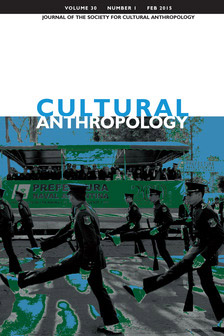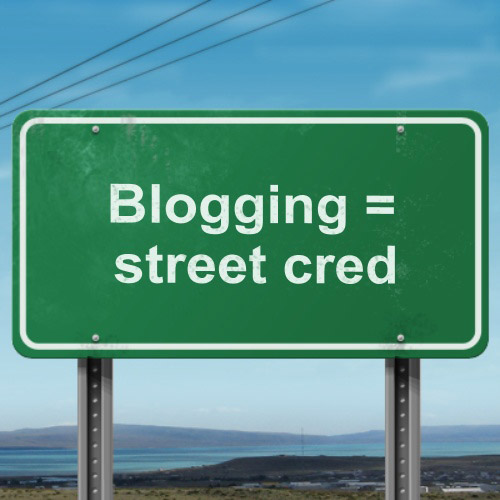
Scholarly publishing in the age of mechanical reproduction. Engraving of a typesetter Blower, forerunner of the Linotype, scanned by Frédéric Bisson, New Universal illustrated encyclopaedia, supplement and biographical dictionary, sixth volume, J. Trousset. Public domain.

Cultural Anthropology 30.1, February 2015. Copyright 2015 Cultural Anthropology/American Anthropological Association, some rights reserved.
I’ve been thinking about academic publishing lately. Some of that is related to being in the middle of Michigan State University’s tenure process. It also has to do with having chaired an ad-hoc committee to revise my department’s annual review process. It also has a bit to do with Issue 30.1 of the journal Cultural Anthropology (CA) being released last week.
Since graduate school, I have wandered the borderlands between Anthropology, Game Studies and Science and Technology Studies. I’ve been (somewhat oddly sometimes) employed by “communication” colleges of various sorts, in part due to Game Studies having found its most disciplinary home in such locations. But I think most importantly it has put me in conversation with a variety of approaches to and perspectives on what academic scholarly activity should/ought/might look like. Add to this my work as a game designer/developer and conversations within the institutions I inhabit how those materials should/ought to/might be evaluated.
More recently, however, I’ve “had some feels,” and I wanted to offer up to the CASTAC community the suggestions I offer my students: It is rough being a junior scholar in a young field starting to find a broader voice. It is even more complicated when “senior” scholars in a field (like Game Studies) are often only one, two or three cohorts apart (and less than a generation) from those only now finishing PhD programs or established enough within graduate programs to feel they have something to offer to broader conversations. Some of these people ran face-first into the hiring cycles of 2008 and 2009 and again the subsequent migration of scholars in 2012 and 2013. Some benefited and some faltered. I have been fortunate.
Increasingly I’ve seen junior scholars taking to “new” platforms to voice perspectives on all variety of scholarly topics. “Social media” (whatever the hell that means) is undoubtedly an element of what most scholars are expected to do (for better or worse). But, a Twitter feed is not a scholarly publication. A Storify is not a journal article. A Tweetlonger is not a book chapter. A blog post or even series of blog posts is not a book. Much of this is “just” part of what scholars do as part of making themselves and their work more well read (again, for better or worse). But, the reality is: as a scholar I am under no obligation to reference or cite these musings. I may do so, because I respect/care for many of the young scholars reaching out via these platforms. I may have been impressed and compelled by the ideas being advanced. But, I’m not obligated to in the same way that I am to engage with “traditionally” published scholarly material.

Academics, not known for street cred. Image by Gideon Burton, some right reserved.
“Now, wait a minute, you’re perpetuating the cycle….” Well, yes. And no. Here is the problem. Academic publishing does have issues. We know that, but I want to have a conversation about these topics. And Twitter isn’t a conversation; it pretends to be, but it isn’t. Even this blog post. It isn’t a conversation. The reality is that smart people like T.L. Taylor, Mia Consalvo, Gina Neff and others have significantly informed my thinking about this topic, but I’m not referencing them nor the smart people who have informed their thinking. That isn’t what a blog post is. But, good academic publishing is supposed to be precisely that conversation. That’s the point. To push back further, in a Storify, frequently one person advances their argument placed oppositional to another individual’s point (or several others), but doesn’t pay attention to those who have already attacked said point previously, unless it was part of the Twitter conversation in that moment. It isn’t like most Storifys go back in time to search out supporting evidence or Tweets that came before said author’s revelation. These platforms discourage memory or historical context. Those platforms desire NOW.
To be clear, I’m vaguely referencing a conversation that has been occurring on social media around Game Studies. That conversation was complicated and I can’t unpack it here and nor do I care about arguing about “formalism” in games. However, I do want to discuss how the structure of the argument reifies the structure it seems to contest. And none of this is to say that those platforms can’t produce rich scholarship. They can and do sometimes. But demonstrating consistent quality over time is much more difficult when pointing to many of these platforms.

The Peer Review Monster: Now I AM scared. Image by Gideon Burton, some rights reserved.
Literature reviews and peer review are about paying attention to evidence and paying difference to those who came before, supporting or critiquing your position. You need to marshall evidence, which is the point of those references. This is a gathering. Good peer review will often point authors to people who have supported those arguments. Even bad peer review can be productive. I wrote this chapter as a response to a bad review. Often times these polemics actually do the opposite academic labor that their arguers are hoping to advance. By writing the polemic attacking a “big scholar’s” perspective, they (purposefully or not) ignore those who have also made those critiques. It actually re-entrenches the problem just as badly as the problem itself. Rarely (very rarely) when I review an essay do I suggest a rejection. Most often I see it as my job to mentor and coax the most of scholarship. But I want authors to pay attention to those who have advanced similar arguments. It helps those arguments. Will I occasionally suggest my own work if it relevant? Yes. Will I feel horribly guilty when I do that? Yes. But, in some cases that may be precisely why I was selected as a reviewer.
Many of us in academia have complicated feelings regarding all things academic publishing: peer review, open access, publish for profit…. I think CA has attempted to stay ahead of the curve on this point. Of course, I’m biased, being involved early on. I think that is one of the most interesting things that CA has encouraged over the years: attention to the internal conversations on any given set of topics. Curated collections, photo essays, and the intern program are excellent examples of these intersections.
Thus, I want scholars to do both: write experimentally with these new platforms and on the old. Both are important. I don’t deny the importance of the new. But I also want you to publish traditional journal articles, books and book chapters. It is ok if they aren’t in the biggest name journals. That is partially how we encourage the uptake of new journals. I will reach out and say, “What have you written on X?” I do that in part because delightful more senior scholars have done the same for me. I’ll ask because you’ve blogged or Tweeted or Storify-ed it previously. But I’ll likely need something at least kind of traditional, something in between. So, for better or worse, I want you to do all of it, because it will make your work better. It will help me argue with older traditional colleagues that you are worth hiring or worth tenuring. I want you here, but your Paste Magazine article, no matter how many hits it has will likely not turn the head of some senior faculty member.

5 Comments
Have you ever read Jessica Falcone’s The Hau of Theory? This made me recall that piece.
That said, it seems a shame that the experimental writing is a privilege of the senior scholars, because it doesn’t count for tenure for the juniors. Hard to find the time to do both, but worth it to engage new audiences. I’m not really sure where I want to do any alc-ac/unconventional writing of my own, apart from here, however.
Elizabeth… Thanks for the connection. Very apropos. The article can be found over on WB.
One of the things I’d like to see is earlier experimentation (for those with the desire). Combined with traditional scholarship it actually makes it easier to argue for the value of those venues. But, like you say, for many it is a privilege of made careers and not those in the making. I think it doesn’t have to be that way, but junior folk can’t jettison the traditional either.
Like you, the amount of effort and time it takes to experiment can take a great deal of time an energy, particularly that young scholars may not have.
Speaking of not doing my homework particularly when blogging…
There is a wonderful reflection on peer review over on Savage Minds that speaks to a different issue, but a related one.
Thank you for this fascinating reflection. I’ve been thinking about many of the same questions myself but coming up with some slightly different feelings, if not answers.
Before I was an anthropologist, I was an artist. As an artist I worked on sculptural installations – often installing objects in places like the outsides of dedicated cultural spaces such as museums, as guerrilla installation. My gallery installations also played with this idea. This has led me to think about how we can get coherence across different sites and scales of thinking, writing, and knowledge production.
I think this is very close to the question you’re addressing. Scholars are blogging, tweeting, posting to Facebook, storifying, using tumblr – they are producing, remixing, sharing, and posting content across multiple sites and scales. At some point all of this is supposed to be brought together into a final (for now) form and published as an article. At that point most of it is edited out, citations are inserted, the material is targeted to particular journals or disciplines, etc.
But without discarding it, I would suggest that this kind of “document” is an anachronism to the way many of us are actually thinking and working today. We can see this increasingly with recent expansions of what it means to write a dissertation – such as the dissertation as graphic novel by Nick Sousanis and other related experiments where dissertations are taking the form of web sites and other shapes beyond the document.
I find myself creating knowledge across multiple scales and sites and yet despite the fragmented nature of this work, it also has a strong coherence when you consider it all together. The demand to aggregate that distributed knowledge into a statement, story, or finality, into a single document, a static text, is a burden but also a throwback to earlier models of writing, production, and publication. So I’ve been asking myself and writing (and tweeting!) about this question: How can we think and write with distributed engagement across these sites and scales? How can we move beyond “the document”? How can we engage with the product of that activity? Can it coalesce in a way that allows it to be transmitted, captured, received, archived?
Drawing on my work as an artist and my theories about sculpture, this project introduces and explores my notions of “installations of meaning” and “proximity syntax,” and addresses what it means to produce “sculptural discourses” across sites and scales.
This is all very early, and incomplete thinking. But I have written about it and collected some of these thoughts in a post here: Installations of Meaning: Sculptural Discourses in Site/Scale Suspensions
I hear your call for publishing in both formats. And I think you’re exactly right. And I’m increasingly noticing the way that document production continues to erase, edit out, or just neglect so much of the vitality of thinking, collaborating, and engagement going on across these many sites and scales we engage in today.
And so, I recognize the value of the journal article, the book, etc. But I wonder what the future holds.
Michael… Thank you for such a thoughtful reply. It is actually that intersection of the creative that prompts a lot of this for me. I’m in a Media and Information department, so you have me (eek!), communication theorists, economists, computer scientists, documentary film makers, game makers, …
But finding ways to bridge the various creative scholarship that each of them does is the key. Unfortunately it means the hybrid ones get to do the foot-work. But when a game maker publishes an article, it makes it easier to argue for the game. When the journal pub person does a documentary… Ultimately it is about understanding the affordances of each medium (is the message) and making it work.
Super great reading of what I was trying to say (I hoped I was saying). Thank you.
1 Trackback